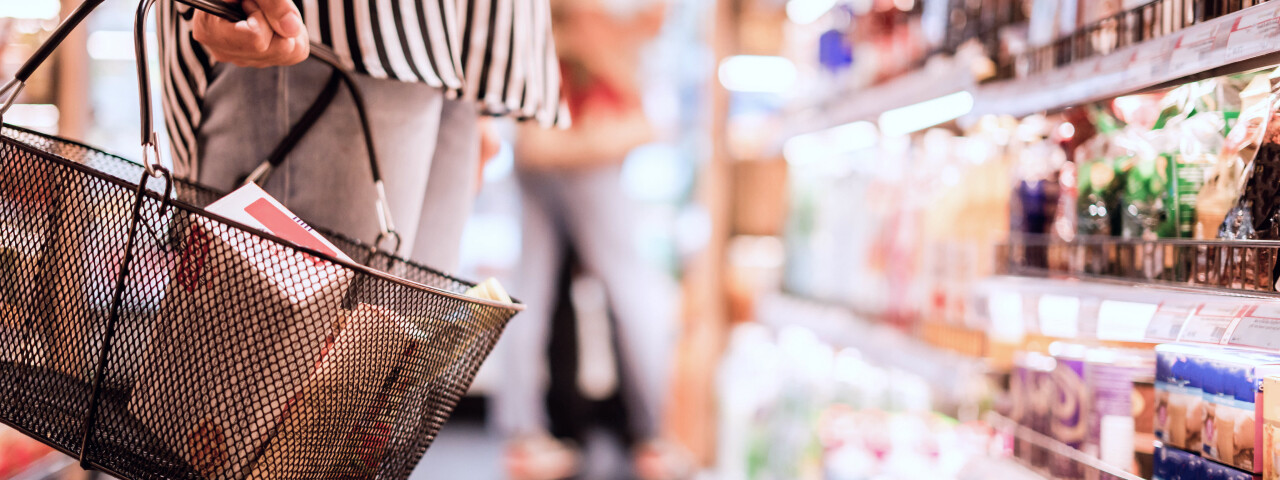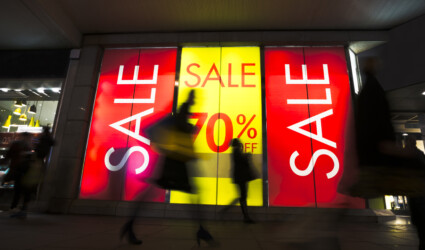
We have entered the new defining point for retailing. Success now means paying closer attention to the trends related to how customers spend and shop in the face of the rising cost of living, new promotional baselines, and stagnant innovation. Although U.S. retail pricing has stabilized a bit, and as fuel prices subside from their 2022 heights, continuing conflict in spending priorities between food and general merchandise should not be underestimated.

“Consumers’ mindset is that we are either in a recession or preparing for a recession, so they are already deploying a recessionary posture toward discretionary purchases,” said Don Unser, president of general merchandise retail thought leadership. “Shoppers have been prioritizing, and will continue to prioritize, services and food over general merchandise items.”

One of the bigger stories to watch this year is employment — generally, and in the retail world. It’s clear the retail industry in 2023 will be planned downward from 2022, as retailers start to hire fewer people and look for ways to tighten their fiscal belts. “It will be a tougher year from a growth perspective, and business leaders will focus more on maximizing profits than pushing volume,” said Marshal Cohen, chief retail industry advisor. “Retailers and manufacturers will both deal with the effects of stagnant product innovation and a paradigm shift in how, when, and how much products are promoted.”
Retailers and manufacturers are looking ahead to 2023 — charting a new normal for retailing as older, unworkable standards and models get renovated or packed away. Read on to see how our industry experts perceive the road ahead.
Maximizing the Opportunity with Minimized Apparel Spending

Kristen Classi-Zummo, Industry Analyst, NPD
After the past two years of unbridled consumer spending, the apparel market will need to develop a more defensive strategy in 2023, in the wake of a more cost-conscience consumer. Creating the right value proposition and understanding how core categories will play into this will be key to maintaining market share. For example, consumers may not be able to splurge on a new outfit for an event this year, but think about “micro-upsell” opportunities: Could a cardigan or belt work with last season’s best-selling dress to make it feel fresh? Maximizing usage occasions and highlighting versatility and value will be winning purchase motivators for a more careful consumer.
- Other issues. We can expect continuing excess inventory in the first quarter of 2023. Consumers will still buy apparel, but consumers’ needs will outweigh the “nice to have.”
- Inflation. Continued inflation in CPG, grocery, and other essentials will lead consumers to spend less on apparel. During the first nine months of 2022, apparel sales revenue remained high, even though demand was cooling. That higher spending will be tough to reprise in 2023, as inflation cools and demand remains soft.
- Employment insecurity. Based on early economic indicators, we can expect to see some corporate layoffs in the first quarter and a bit of a spending pullback overall.
From Accessories to Necessities

Beth Goldstein, Industry Analyst, NPD
U.S. accessories categories will be challenged this year to regain share of consumers’ wallets amid shifting priorities, but opportunity does exist. There is still headroom for travel goods to return to pre-pandemic unit sales levels. Function and fashion in bags and luggage go hand in hand, across all price points, so messaging and storytelling that showcase features and benefits will remain important.
- Luggage sales revenue has risen well above 2019 levels., but unit sales are still down slightly. New travel behaviors will provide opportunities for continued growth.
- Handbag category salesremain soft. Even the luxury business has slowed, demonstrating it is not immune to macroeconomic pressures.
- The accessories channel landscape is changing as direct-to-consumer (DTC) gains share. In addition, social media will continue to be a strong purchase influence.
Beauty’s Resilience Has
Layers


Larissa Jensen, Industry Advisor, NPD
NPD forecasts overall industry growth for the U.S. prestige beauty market over the next several years. This will be driven in part by consumers who continue to indulge. The past year taught us the beauty industry is resilient. The most successful businesses will leverage best practices from winning markets, recognize and adapt to changes in the macro environment, and connect with consumers in new and unique ways.
- Regardless of whether consumer confidence was up or down, prestige beauty growth remained strong. The factors supporting this phenomenon — including higher income consumers, the redefinition of wellness, and an increase in socialization — will continue to fuel positive performance this year.
- About half the U.S. prestige beauty shopper base earns over $100,000 per year. These consumers are less likely to cut back on spending during challenging economic times. If these higher-income consumers remains less affected by the economy, they should maintain their indulgent mindset into 2023, which will benefit higher-end beauty sales.
- While physical wellness remains important, consumers are focusing on their mental wellness more than ever before. This shift began in 2020 and has only accelerated since then, contributing peripherally to the sales of beauty products. There are very few industries outside beauty that are better positioned to meet consumers’ emotional needs.
- Some challenges of the pandemic remain, but its impact has been minimized in consumers’ minds. As we move further away from the shock of 2020, we will settle into more normalized behaviors. This will include going out and gathering with each other, which should lead to increased beauty sales.
Books Can Expect Plot Twists in the Next Chapter


Kristen McLean, Industry Analyst, NPD
After two record-breaking years, the U.S. book publishing market will enter a period of major adjustment in 2023. While adult fiction and other areas of the market were strong in 2022, overall purchasing slowed, and some high-value areas, including new adult non-fiction titles, significantly underperformed expectations. As consumers cut back on spending, there are few strong signals about what content areas will be compelling in 2023.
- Cost reductions, strategic pricing requirements, and only wanting “sure bets” on the shelf all will be likely outcomes of a consumer pullback in book buying. As a result, innovation and delight may be harder for consumers to find on bookshelves in the coming year.
- New sales boosters, like #BookTok and page-to-screen adaptations on streaming media apps, will remain strong.
- The market will favor companies that innovate, and we will see those companies gain share in 2023.
Footwear Will Need to Keep Pace with Changing Demands



Beth Goldstein, Industry Analyst, NPD
This will be a reset year for footwear. After three years of ups and downs, which varied by category, channel, and brand, sales and price trends will level out as consumers settle into their now-familiar pandemic-era lifestyles and continue to grapple with macroeconomic pressures. As they make choices about their must-haves versus their nice-to-haves, brands and retailers will look to clear excess inventory, setting themselves up for tighter assortments moving forward.
- The return to workplaces, socialization, and other activities that propelled the more dress-oriented categories in 2022 will have less impact this year, shifting demand toward more casual, but versatile, items.
- The athleisure business will remain important, but it will continue to face headwinds. We’ll see this in shifting market dynamics and the popularity of some key brands and products in both the casual fashion and performance athletic space that have similar end uses.
- Footwear online penetration settled in at 40% of sales in 2022, in line with 2021, and 10 points higher than pre-pandemic. This is not expected to change materially in 2023.
Foodservice Gets Its Crave
Back


David Portalatin, Industry Advisor, NPD
Foodservice recovery in the U.S. should resume in 2023, as consumer mobility and demand for experiences returns. Foodservice operators that can provide “craveable” eats that offer variety and quality at an affordable price point will gain momentum this year.
- Quick service restaurant (QSR) unit counts have recovered to their pre-pandemic levels. Demand for convenient, on-the-go meals at value price points will allow QSR share growth to continue.
- Morning meal daypart traffic has fully recovered as time-crunched morning routines have made breakfast on the go a good value proposition.
- Non-commercial recovery is gaining momentum in sectors such as lodging, recreation, and business and industry as consumers resume some of their pre-pandemic work and travel behaviors.
Food and Beverage Variety Will Entice Diverse Appetites


Darren Seifer, Industry Analyst, NPD
Inflation pressures in 2022 forced consumers to seek lower-priced food and beverage items to mitigate rising costs. However, prices are starting to stabilize, which should give consumers more predictability to manage their grocery spending. Even if prices remain elevated, people might feel more confident about spending on mainstream and premium items. We saw a similar shift around 2009, following another period of higher inflation, when consumers experienced “frugal fatigue” that led them back to familiar brands.
- Convenience will continue its rise as more consumers leave their homes daily. Look for strength behind frozen and quick-to-prepare meals to meet their needs.
- While off its pandemic high, remote working remains at more than twice the level it was in 2019. This puts consumers near their pantries more often and will keep the number of in-home sourced meals elevated. Those doing hybrid work will have varying convenience needs and, as they account for their commute times, workers will pivot between more complex and quicker meals.
- Marketers should provide offerings for various income groups. If prices remain high, lower-income consumers will still feel the pinch and will continue to source more meals from home, use leftovers, and switch brands. Middle- to higher-income consumers should show signs of recovery, buying more mainstream and premium brands.
Consumer Packaged Goods (CPG) Pricing Will Continue to Disrupt Consumer Behavior


Dr. Krishnakumar “KK” Davey, President of Thought Leadership for CPG and Retail, IRI and NPD
Even with inflation easing, it will remain stubbornly high compared to historical standards. This will cause ongoing consumer demand shifts with lower unit and volume sales as consumers look to curb waste and shop smart.
- Consumers will see increasing promotions, which will provide some relief from inflationary pressures, but the depth of promotions won’t match pre-pandemic levels. They also will seek savings by shopping value and club stores. Shifting to private-label offerings is yet another way they’ll combat higher prices.
- At the same time, the market will continue to bifurcate: Some consumer segments will purchase premium-priced goods that are differentiated and offer superior benefits, and others will seek the occasional splurge to elevate an occasion.
Home Is a Haven Consumers Return To


Joe Derochowski, Industry Advisor, NPD
This will be the year of recalibrating, restructuring, and reprioritizing. Consumers will start to re-calibrate their spending, shifting from the carefree pandemic-lifestyle spending to focus on managing inflation and other economic concerns. This shift, along with comparing against the brisk sales enjoyed during the height of the pandemic period, will result in sales declines for many housewares and home improvement categories in 2023.
- Consumers will restructure how they spend their time. They will start to settle into a more structured life that still leans toward a home-centric lifestyle. Eventually, this home-centric lifestyle will create a need to replace and upgrade products purchased during the early months of the pandemic.
- Manufacturers and retailers should invest in product innovation and marketing to meet consumers’ “new normal” needs and inspire them with new solutions.
Consumer Technology Struggles Give Way to Selective Growth


Paul Gagnon, Industry Advisor, NPD
After a challenging year for the consumer technology market in 2022, following two very strong years of growth during the pandemic, challenging economic conditions will again pressure spending on tech products in 2023. Replacement cycles for many technology products extend at least three years, and sometimes up to seven years. The wave of device replacements related to pandemic-driven upgrades won’t begin until later in 2023, but more likely in 2024 and 2025. There are areas of the market where growth looks likely this year, especially if manufacturers can introduce innovative products that have been somewhat lacking during the pandemic.
- TV unit sales are likely to grow by low single digits as prices become more affordable at all sizes. Home streaming video entertainment typically provides good value for consumers in an otherwise challenging economy.
- While the overall computer category will continue to be pressured in 2023 due to the massive surge in demand in 2020 and 2021, the Chromebook market might start to see some growth again at the most affordable end of the computing spectrum.
- Home automation products grew in 2022, even after strong demand during the pandemic, and that trend should continue in 2023. More affordable models will be coming to market. There will be an expansion of products using the new Matter smart-home standard.
Mobile Devices Face Immobilizing Headwinds


Brad Akyuz, Industry Analyst, NPD
The smartphone market’s momentum stalled in the fourth quarter of 2022 due to supply challenges. This has given U.S. mobile carriers the perfect excuse to scale back on device subsidies, especially when it comes to upgrades. This shift in the promotional narrative will take its toll on smartphone volumes and revenues in 2023, because smartphones upgrades, especially in flagship models with hefty price tags, are highly dependent on mobile carriers’ level of subsidy generosity.
- Two-thirds of all smartphones are sold directly through mobile carriers. The Federal Reserve’s ongoing rate hikes continue to increase the cost of postpaid carriers’ device financing programs (that range between 24 to 36 months), thus lowering their subsidy generosity.
- The four-year trend of prepaid-to-postpaid migration will slow down and possibly reverse in 2023. Economic headwinds will force financially challenged consumers to seek cost-cutting service downgrades, instead of pursuing upgrades.
- Cable mobile virtual network operators’ (MVNOs’) aggressive pricing on mobile/cable internet bundles, coupled with the emergence of new low-cost service providers, will ignite race-to-the-bottom pricing wars, which the consolidated U.S. mobile market has remarkably avoided for years. Anticipated declines in service revenues will limit carriers’ subsidy amounts on smartphones. Cable MVNOs’ bring-your-own-device (BYOD) business model is another inhibiting factor for new smartphone sales.
B2B Technology Sales Temporarily Tempered


Mike Crosby, Industry Analyst, NPD
While B2B tech sales experienced strong unit and revenue growth in 2022, inflation emerged as a significant headwind. Costs for raw materials, manufacturing, and labor rose to nearly 40-year highs. To combat rising inflation, the Federal Reserve tightened monetary policy to help cool an overheated economy with the hopes of bringing inflation down to more acceptable levels. These policy changes, along with continued higher inflation levels, are expected to temper business technology investment in 2023.
- While overall corporate budgets are expected to be under pressure in 2023, information technology (IT) investment is expected to remain the same or even increase, because technology continues to be viewed as a critical necessity to increase productivity. Midsize and enterprise companies will continue to make investments; smaller businesses will likely see lower levels of investment, as ongoing financial pressure and lingering inflation complicate the existing supply-chain and labor challenges they face.
- The IT investment mix will continue to shift away from hardware to software, cloud, and managed services in 2023. Hardware represents the majority (58%) of anticipated IT spending, but software, cloud infrastructure and managed services will continue to grow, though this growth will be more muted than it was in 2022. Average selling prices are also expected to normalize, as price declines will lag cost improvements seen upstream.
- Big improvements in economic conditions are anticipated in 2024 and 2025, with inflation nearing target levels and the supply chain operating in a more predictable manner. B2B tech demand is expected to accelerate, driven by overall economic expansion along with a significant technology refresh for client devices that were deployed early in the pandemic.
Toys Need to Excite the Big Kids


Juli Lennett, Industry Advisor, NPD
Like last year, 2023 will bring about bright moments and deep groans. With a more significant theatrical calendar this year compared to the last three years, the U.S. toy industry will be poised to enjoy the fruits of several tentpole movies. However, if inflation and other adverse macroeconomic factors linger later in the year, or become worse, we can expect to see families pulling back on the number of toys they purchase or trading down to lower price points.
- The first three quarters will face challenging comparisons; increases in average selling prices drove revenue gains last year. With Easter falling in early April this year, the first quarter will benefit the most from those Easter purchases and put added pressure on the second quarter.
- Outside the economic factors, losing the “kidult” consumer (aged 12 and older) is possibly the largest threat the U.S. toy industry faces this year. Kidults were the largest segment for toy sales — they were responsible for most of the growth in the year ending September 2022. About one-quarter of toy sales, or $9.3 billion annually, are purchased for the kidult age group. More importantly, this group represented $1.7 billion in sales revenue growth, which was 58% of the growth in the last year.
- This growth in kidult sales has been a huge windfall for the toy industry, particularly for categories like building sets, plush, action figures, and sports trading cards. If this group of toy consumers loses interest in toys, it would have a significant impact. Manufacturers will need to dig deep with the right products and strategies to keep this train running.
Video Games Play On, Looking to Beat the Next Level


Mat Piscatella, Industry Analyst, NPD
The U.S. video game market is poised to return to its long-term trend of sales and player engagement growth. Improved supply of new-generation hardware, such as the PlayStation 5 and Xbox Series consoles, a highly anticipated slate of new premium games, and improved demand for accessories, such as gamepads and headsets, could combine to make this year a very special one for the industry. The market also has several developing segments, such as VR/AR/XR, cloud, and subscription services, that may provide additional growth opportunity.
- How high is the ceiling for PlayStation 5 and Xbox Series consoles? Although supply improved throughout the fourth quarter of 2022, constraints remained a challenge, limiting overall sales potential. When full supply is achieved, this generation might set new sales records.
- Which new video game releases will reach blockbuster status? The pandemic’s onset proved challenging for video game development, leaving the 2022 slate of new releases lighter than most years. With the many games delayed into 2023 joining those already planned, it could quickly become a very competitive and exciting market.
- Will improved console supply and the upgrade cycle bring accessories back to growth? Sales of headsets, headphones and gamepads, and other video game accessories surged in early 2020. Players now may look to upgrade these accessories, joining new hardware adopters to potentially boost overall sales.
Office Supplies Holds Steady with Normalizing Consumer Lifestyles


Tia Frapolli, President, Office Supplies, NPD
U.S. office supplies industry revenue in 2023 is expected to decline 1% year over year but remain 7% above pre-pandemic (2019) sales (excluding storage categories as well as janitorial and breakroom supplies). In fact, industry revenue should remain above 2019 totals through 2025,shown by our Future of Office Supplies report.. Continued innovation will be key to uncovering opportunity in the office supplies industry. Evolution related to product features, creative product use-case methods, and category revitalization through new designs or target market segments will help drive category growth.
- While the effect of new technology on office supplies sales is often viewed as a concern, three-quarters of consumers plan to purchase the same or more supplies this year, despite the growing use of technology. This NPD survey finding indicates unit sales for school supplies should remain relatively stable over time.
- Unit demand could return to the office supplies industry this year, as in-person learning continues to grow. Last year, some school districts provided additional funding to purchase supplies for classrooms and/or student needs, which could have affected retail unit sales of school supplies during the peak period of the back-to-school season. The industry might see unit demand return this year, as teachers increasingly rely on the school list to fund the classroom.
- The work-from-home and hybrid consumer segment home-office setup activation has begun to normalize. Future growth will come from either replenishment or through identifying new workers who are likely to be in industry verticals that have flexible-work philosophies.
Automotive Aftermarket Sales Show Resilience


Nathan Shipley, Industry Analyst, NPD
The retail automotive aftermarket as resilient throughout the pandemic; more consumers turned to their garages for do-it-yourself projects. This was coupled with the freedom car ownership provides — families turned to their personal vehicles to take road trips near and far. Others bought RVs, boats, or other motorized equipment for recreation. The aftermarket benefited as a result. More recently, while topline dollar sales have remained positive, unit sales have declined as pre-pandemic behaviors have reemerged. Separately, higher gasoline prices have impacted spending on vehicles.
- Product pricing has been a very hot topic: The aftermarket is at the top of the list of our tracked industries when it comes to average price increases.
- The average increase this year has been over 15%, with the most recent weeks up almost 20%.
- This change has been driven by numerous factors from the merchandising and consumer perspectives, including inflation, promotional and mix changes, new assortments, and other factors.




